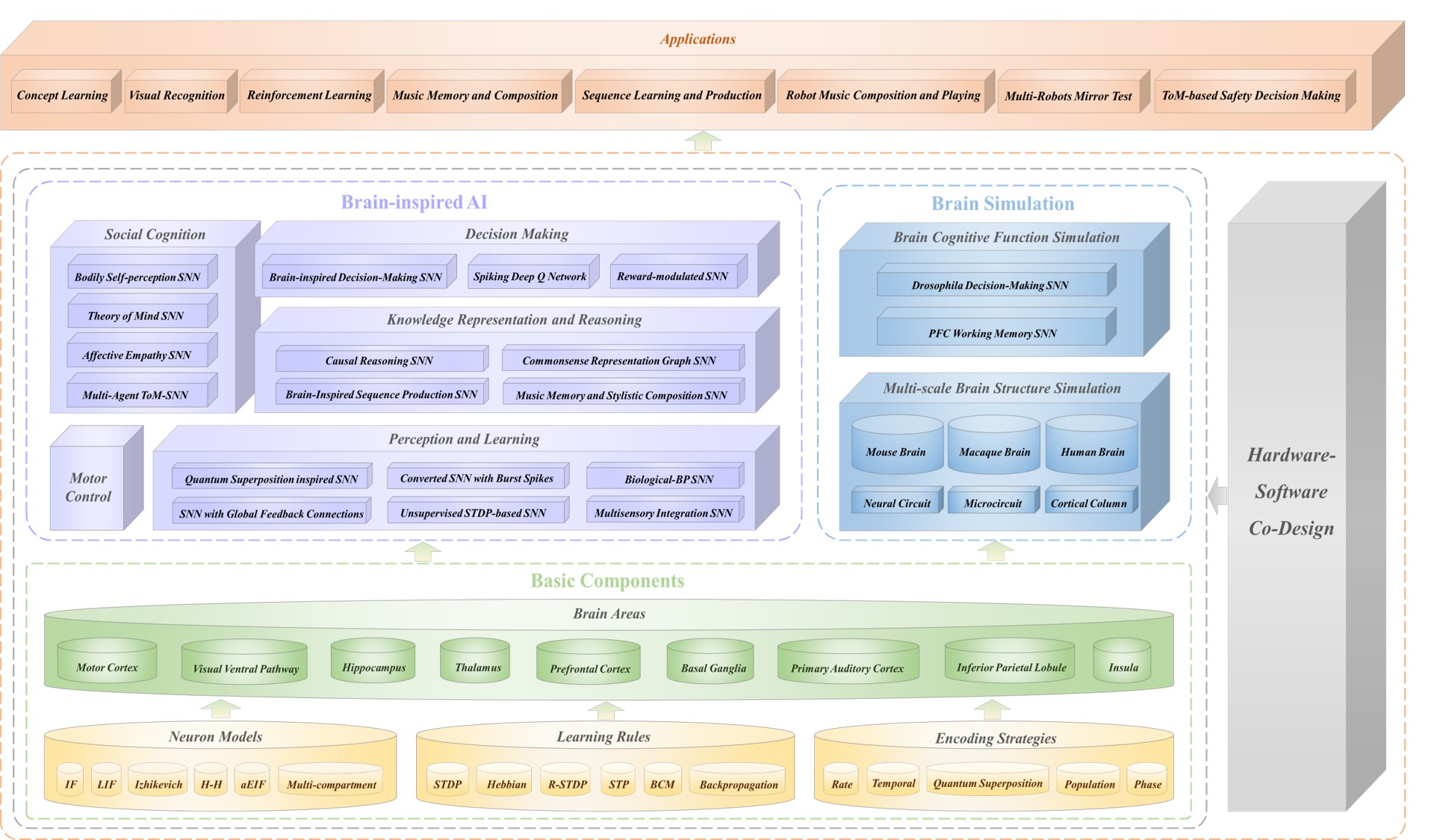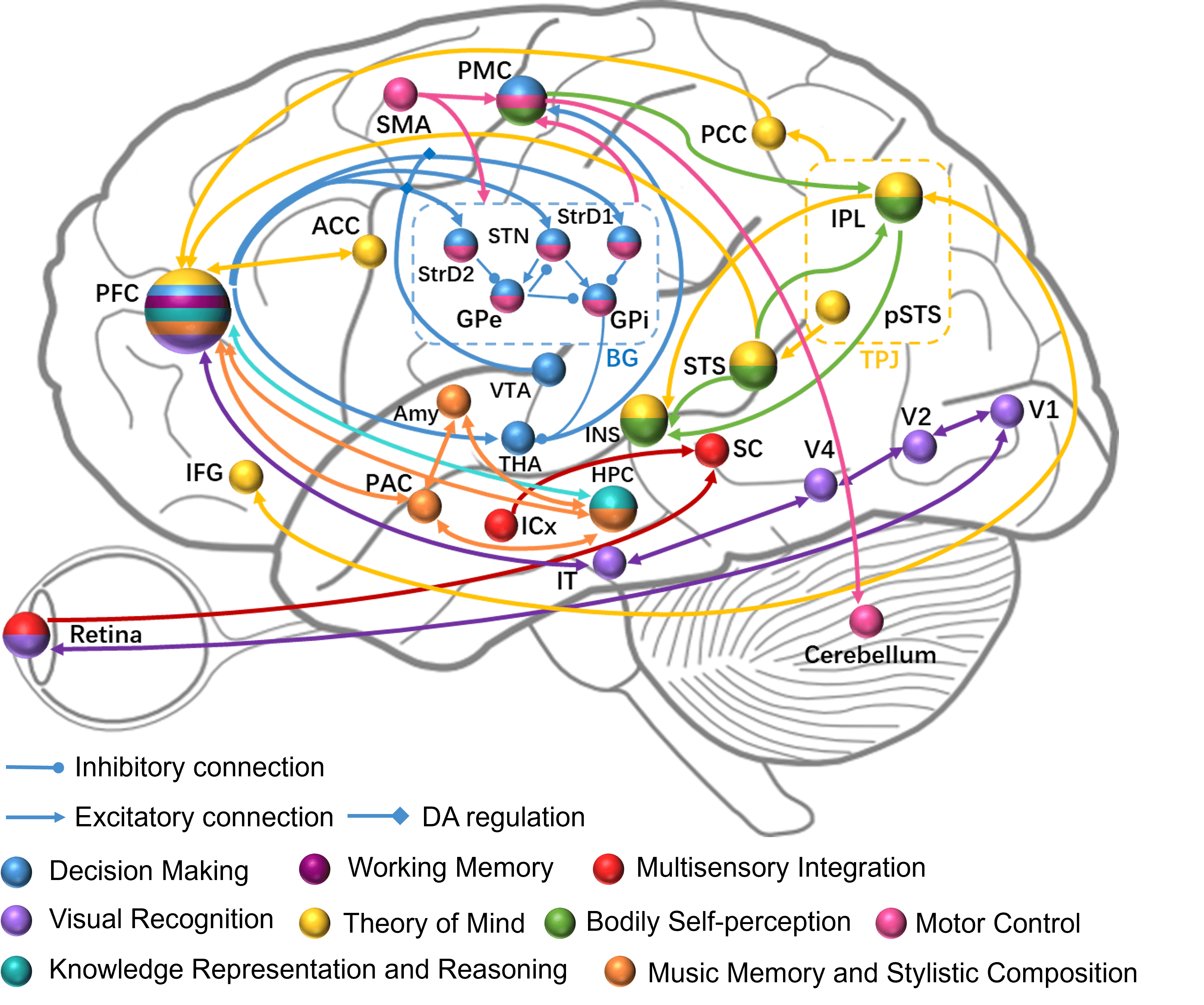







Brain-inspired Cognitive Intelligence Engine (BrainCog) integrates multi-scale biological plausible plasticity principles, supports Spiking Neural Network based brain-inspired Artificial Intelligence modeling, and brain function and structure simulation. BrainCog provides complete and systematic interface components for researchers in brain-inspired AI and computational neuroscience.
BrainCog allows researchers to freely design their own network and the corresponding functions by calling and connecting the essential modules. For Brain-inspired AI, BrainCog collaborates with multiple brain regions to form different neural circuits and preliminarily implements five categories of cognitive functions: Perception and Learning, Decision Making, Motor Control, Knowledge Representation and Reasoning, and Social Cognition. BrainCog also realizes partial brain cognitive function simulation, as well as the structure and mechanism simulation of different biological brain from multiple scales. Currently, the field of brain-inspired spiking neural networks lacks an open, fair platform to evaluate the performance of algorithms in the same environment. BrainCog integrates multiple high-performance, easy-to-modify SNN models that have been effectively validated on various benchmark tasks. Users can evaluate their own algorithms in the same environment and compare them with other methods. You can also easily implement your own algorithms using the components provided by BrainCog and compare them fairly with other state-of-the-art methods.

BrainCog is aimed at providing infrastructural support for specialized, generalized Brain-inspired AI. Currently, it provides cognitive function components that can be classified into five categories: Perception and Learning, Decision Making, Motor Control, Knowledge Representation and Reasoning, and Social Cognition. These components collectively form neural circuits corresponding to 28 brain areas in the mammalian brains. These brain-inspired AI models have been effectively validated on various supervised and unsupervised learning, deep reinforcement learning, and several complex brain-inspired cognitive tasks.

BrainCog provides a variety of supervised and unsupervised methods for training spiking neural networks, such as the biologically-plausible Spike Timing-Dependent Plasticity (STDP), the backpropagation based on surrogate gradients, and the conversion-based algorithms. In addition to high performance in common perception and learning process, it also shows strong adaptability in small samples and noisy scenarios. BrainCog also provides a multi-sensory integration framework for human-like concept learning.
BrainCog provides multi-brain areas coordinated decision-making SNN model and deep reinforcement learning SNN.
BrainCog has preliminarily implemented control of the motion of humanoid robots by spiking neural network.
BrainCog performs knowledge representation and reasoning by incorporating multi-neural plasticity and population coding mechanisms.
BrainCog implements a biologically plausible brain-inspired social cognitive spiking neural network model.
BrainCog can support simulations of brain structure and cognitive function at different scales, thus providing powerful support for computationally validating scientific conjectures and scientific explanations from local and whole brain scales.
BrainCog realizes Drosophila linear and nonlinear decision-making and prefrontal cortex (PFC) working memory function simulation.
BrainCog provides simulations of brain structures at different scales, from microcircuits, and cortical columns, to whole-brain structure simulations. Anatomical and imaging multi-scale connectivity data is used to support whole-brain simulations from mouse brain, macaque brain to human brain at different scales.
BrainCog Embot is an Embodied AI platform under the Brain-inspired Cognitive Intelligence Engine (BrainCog) framework, which is an open-source Brain-inspired AI platform based on Spiking Neural Network.

